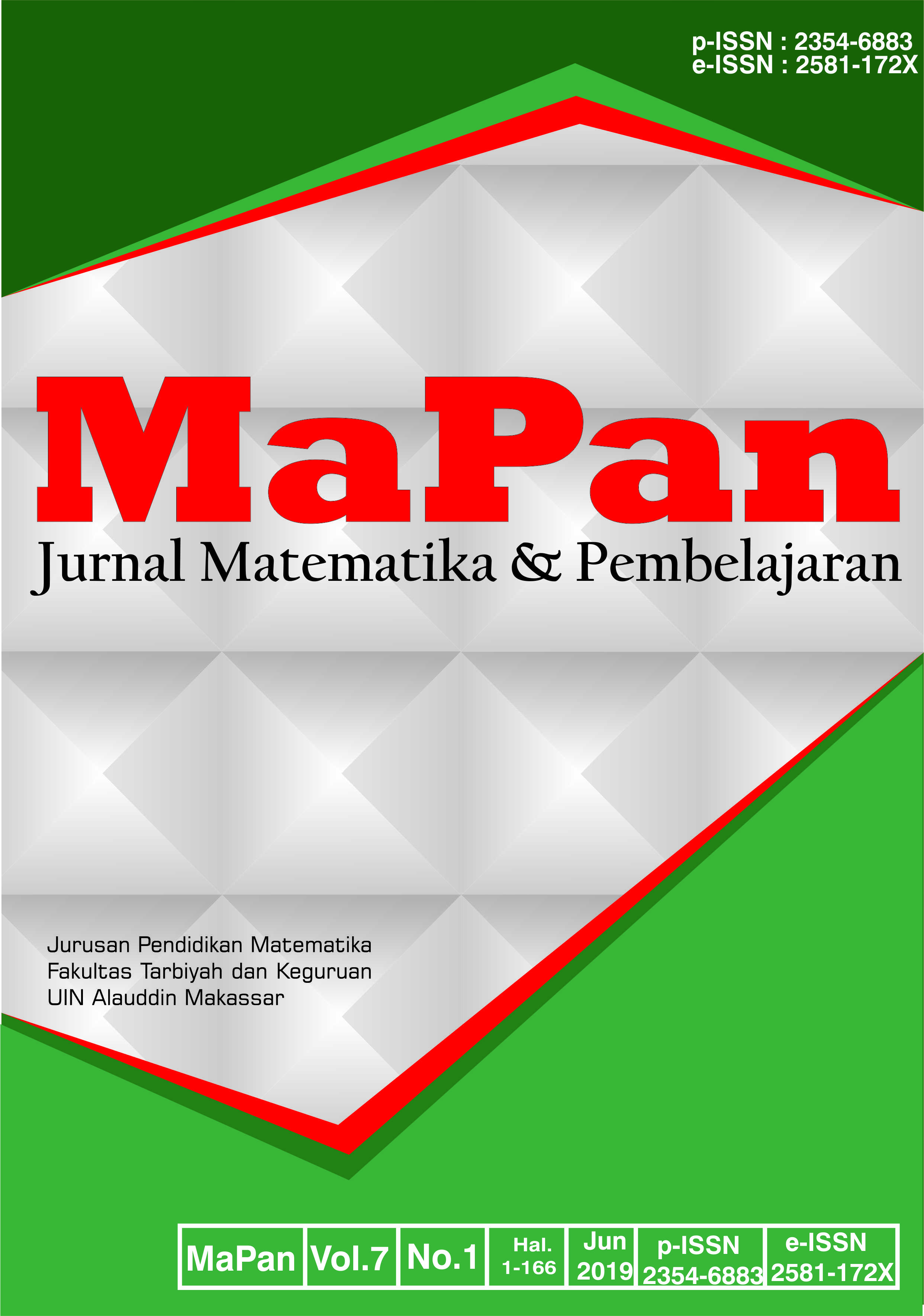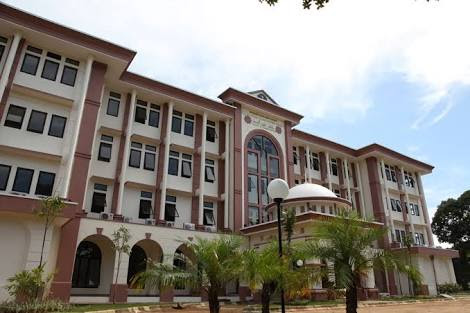INTEGRASI ETNOMATEMATIKA DENGAN MODEL PEMBELAJARAN PROBING-PROMPTING UNTUK MELATIH KOMUNIKASI MATEMATIS SISWA
Abstract
Abstrak:
Etnomatematika menjadi kajian tren penelitian saat ini. Etnomatematika memberikan pengaruh positif dalam pembelajaran matematika dengan melibatkan potensi budaya. Matematika perlu dikomunikasikan dengan menyisipkan budaya sehingga siswa mudah memahami materi. Oleh karena itu, etnomatematika perlu diintegrasikan dengan suatu model pembelajaran. Dengan demikian, tujuan penelitian ini adalah untuk mengembangkan perangkat pembelajaran model probing-prompting berbasis etnomatematika yang dapat melatih komunikasi matematis siswa. Penelitian ini menggunakan model pengembangan Instructional Development Institute (IDI) dengan tiga tahapan, yaitu menentukan, mengembangkan, dan mengevaluasi. Subjek penelitian adalah 30 siswa kelas 8 MTs Negeri Sidorejo Banyuwangi. Pengumpulan data dilakukan melalui angket, observasi, lembar validasi, dan tes. Perangkat pembelajaran yang dikembangkan berupa kisi-kisi soal, soal tes, LKS, dan RPP. Hasil penelitian menunjukkan bahwa perangkat pembelajaran memenuhi kriteria valid, praktis, dan efektif. Perangkat pembelajaran ini dapat digunakan guru untuk mengembangkan kemampuan komunikasi matematis siswa.
Abstract:
Ethnomatematics becomes current study trend. It gives positive influence in learning mathematics by involving cultural potential. Mathematics needs to be communicated by integrating culture so that students easily understand the material. Therefore, ethnomatematics needs to be integrated with a learning model. Thus, the purpose of this study is to develop an ethnomatematics-based probing-prompting learning device that can train student’s mathematical communication. The study used a development model of the Instructional Development Institute (IDI) with three stages, namely defining, developing, and evaluating. The research subjects were 30 eighth grade students at MTs Negeri Sidorejo Banyuwangi. Data were collected through questionnaire, observation, validation sheet, and test. The learning device consists of the prediction of test problems, test problems, student’s worksheet, and lesson plan. The result of the study shows that the learning device fulfill valid, practical, and effective criterion. The learning device can be used by teachers to develop students' mathematical communication ability.
Downloads
References
Abiam, P. O., Abonyi, O. S., Ugama, J. O., & Okafor, G. (2016). Effects of ethnomathematics-based instructional approach on primary school pupils’ achievement in geometry. Journal of Scientific Research and Reports, 9(2), 1–15.
Albert, L. R. (2000). Outside-in - inside-out: Seventh-grade students’ mathematical thought processes. Educational Studies in Mathematics, 41(2), 109–141. https://doi.org/10.1023/A:1003860225392
Alfian, M. H., Dwijanto, D., & Sunarmi, S. (2017). Effectiveness of probing-prompting learning models with scaffolding strategy to mathematics creative thinking ability and enthusiasm. Unnes Journal of Mathematics Education, 6(2), 249–257.
Anintya, Y. A., Pujiastuti, E., & Mashuri, M. (2017). Analysis of mathematical communication skills viewed from student learning styles in eighth grader students in learning resource based learning model. Unnes Journal of Mathematics Education, 6(1), 37–43.
Barton, B. (1996). Making sense of ethnomathematics: Ethnomathematics is making sense. Educational Studies in Mathematics, 312(1), 201–233.
Baxter, J. A., Woodward, J., & Olson, D. (2005). Writing in mathematics: An alternative form of communication for academically low-achieving students. Learning Disabilities Research and Practice, 20(2), 119–135. https://doi.org/10.1111/j.1540-5826.2005.00127.x
Brendefur, J., & Frykholm, J. (2000). Promoting mathematical communication in the classroom: Two preservice teachers’ conceptions and practices. Journal of Mathematics Teacher Education, 3(2), 125–153. https://doi.org/10.1023/A:1009947032694
Cai, J., Jakabcsin, M. S., & Lane, S. (1996). Assessing students’ mathematical communication. School Science and Mathematics, 96(5), 238–246. https://doi.org/10.1111/j.1949-8594.1996.tb10235.x
Cooke, B. D., & Buchholz, D. (2005). Mathematical communication in the classroom: A teacher makes a difference. Early Childhood Education Journal, 32(6), 365–369. https://doi.org/10.1007/s10643-005-0007-5
D’Ambrosio, U. (2001). What is ethnomathematics, and how can it help children in schools? Teaching Children Mathematics, 7(6), 308–310.
Darkasyi, M., Johar, R., & Ahmad, A. (2014). Peningkatan kemampuan komunikasi matematis dan motivasi siswa dengan pembelajaran pendekatan Quantum Learning pada siswa SMP Negeri 5 Lhokseumawe. Jurnal Didaktik Matematika, 1(1), 21–34.
Fouze, A. Q., & Amit, M. (2018). Development of mathematical thinking through integration of ethnomathematics folklore game in math instruction. Eurasia Journal of Mathematics, Science and Technology Education, 14(2), 617–630. https://doi.org/10.12973/ejmste/80626
François, K., & Stathopoulou, C. (2012). In-between critical mathematics education and ethnomathematics: A philosophical reflection and an empirical case of a Romany students’ group mathematics education. Journal for Critical Education Policy, 10(1), 234–247.
Gerdes, P. (1994). Reflections on ethnomathematics. For the Learning of Mathematics, 14(2), 19–22. https://doi.org/10.1145/3085228.3085284
Gustafson, K. L., & Branch, R. M. (1997). Revisioning models of instructional development. Educational Technology Research and Development, 45(3), 73–89. https://doi.org/10.1007/BF02299731
Heyd-Metzuyanim, E. (2013). The co-construction of learning difficulties in mathematics-teacher-student interactions and their role in the development of a disabled mathematical identity. Educational Studies in Mathematics, 83(3), 341–368. https://doi.org/10.1007/s10649-012-9457-z
Kostos, K., & Shin, E. kyung. (2010). Using math journals to enhance second graders’ communication of mathematical thinking. Early Childhood Education Journal, 38(3), 223–231. https://doi.org/10.1007/s10643-010-0390-4
Lomibao, L. S., Luna, C. A., & Namoco, R. A. (2016). The influence of mathematical communication on students’ mathematics performance and anxiety. American Journal of Educational Research, 4(5), 378–382. https://doi.org/10.12691/EDUCATION-4-5-3
Martin, C. L. (2015). Writing as a tool to demonstrate mathematical understanding. School Science and Mathematics, 115(6), 302–313. https://doi.org/10.1111/ssm.12131
Massarwe, K., Verner, I., Bshouty, D., & Verner, I. (2010). An ethnomathematics exercise in analyzing and constructing ornaments in a geometry class. Journal of Mathematics and Culture, 5(1), 1–20.
Mayasari, Y., Irwan, & Mirna. (2014). Penerapan teknik probing-prompting dalam pembelajaran matematika siswa kelas VIII MTsN Lubuk Buaya Padang. Jurnal Pendidikan Matematika, 3(1), 56–61.
Motiwalla, L. F. (2007). Mobile learning: A framework and evaluation. Computers and Education, 49(3), 581–596. https://doi.org/10.1016/j.compedu.2005.10.011
NCTM. (2000). Principles and standards for school mathematics. Reston, VA: National Council of Teachers of Mathematics.
Palhares, P. (2012). Mathematics education and ethnomathematics. A connection in need of reinforcement. REDIMAT-Journal of Research in Mathematics Education, 1(1), 79–92.
Pugalee, D. K. (2001). Writing, mathematics, and metacognition: Looking for connections through students’ work in mathematical problem solving. School Science and Mathematics, 101(5), 236–245. https://doi.org/10.1111/j.1949-8594.2001.tb18026.x
Pugalee, D. K. (2004). A comparison of verbal and written descriptions of students’ problem solving processes. Educational Studies in Mathematics, 55(1–3), 27–47. https://doi.org/10.1023/B:EDUC.0000017666.11367.c7
Rofiki, I., Nusantara, T., Subanji, & Chandra, T. D. (2017). Exploring local plausible reasoning: The case of inequality tasks. Journal of Physics: Conference Series, 943(1), 12002.
Rosa, M., & Orey, D. (2011). Ethnomathematics: The cultural aspects of mathematics. Revista Latinoamericana de Etnomatemática: Perspectivas Socioculturales de La Educación Matemática, 4(2), 32–54.
Santos, L., & Semana, S. (2015). Developing mathematics written communication through expository writing supported by assessment strategies. Educational Studies in Mathematics, 88(1), 65–87. https://doi.org/10.1007/s10649-014-9557-z
Sarrab, M. (2012). Mobile learning (m-learning) and educational environments. International Journal of Distributed and Parallel Systems, 3(4), 31–38. https://doi.org/10.5121/ijdps.2012.3404
Sharp, J. (2015). Relationships between the Hopi calendar and measurement concepts. Journal of Mathematics and Culture, 9(1), 30–51.
Shield, M., & Galbraith, P. (1998). The analysis of student expository writing in mathematics. Educational Studies in Mathematics, 36(1), 29–52. https://doi.org/10.1023/A:1003109819256
Sierpinska, A. (1998). Three epistemologies, three views of classroom communication: Constructivism, sociocultural approaches, interactionism. In H. Steinbring, M. G. B. Bussi, & A. Sierpinska (Eds.), Language and communication in the mathematics classroom (pp. 30–62). Reston, VA: National Council of Teachers of Mathematics.
Sousa, J. F. P., & Palhares, P. (2016). (Ethno) mathematical tasks in the context of proportional reasoning. Journal of Mathematics and Culture, 10(3), 101–110.
UCIDT. (1973). Instructional development institute model. Syracuse: The University Consortium for Instructional Development & Technology.
Unodiaku, S. S. (2013). Effect of ethno-mathematics teaching materials on students’ achievement in mathematics in Enugu State. Journal of Education and Practice, 4(23), 70–77.
Copyright (c) 2019 Agus Prasetyo Kurniawan, Ahmad Choirul Anam, Imam Rofiki, Abdussakir Abdussakir

This work is licensed under a Creative Commons Attribution 4.0 International License.


